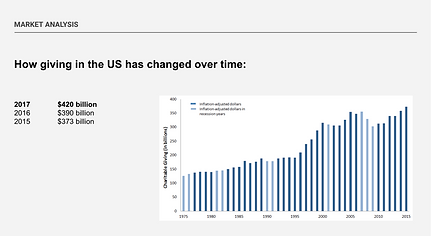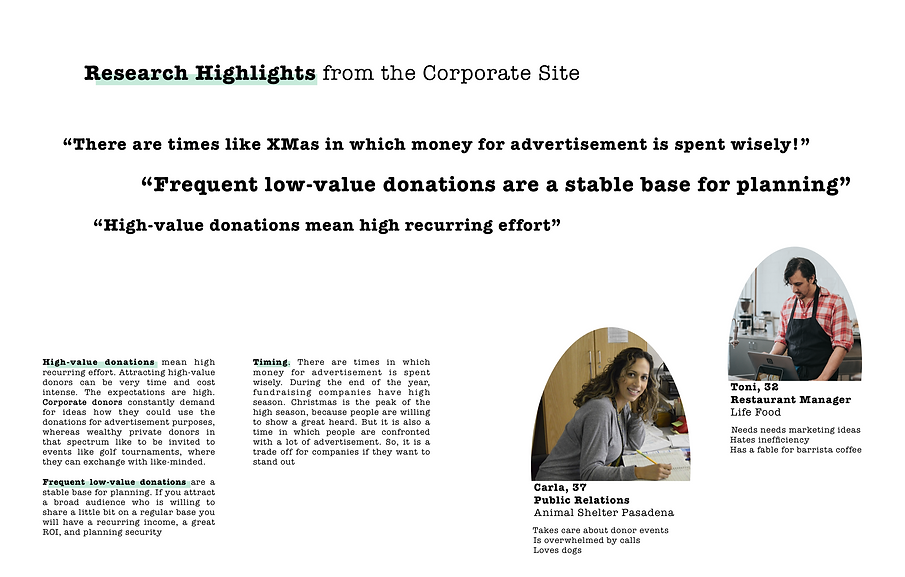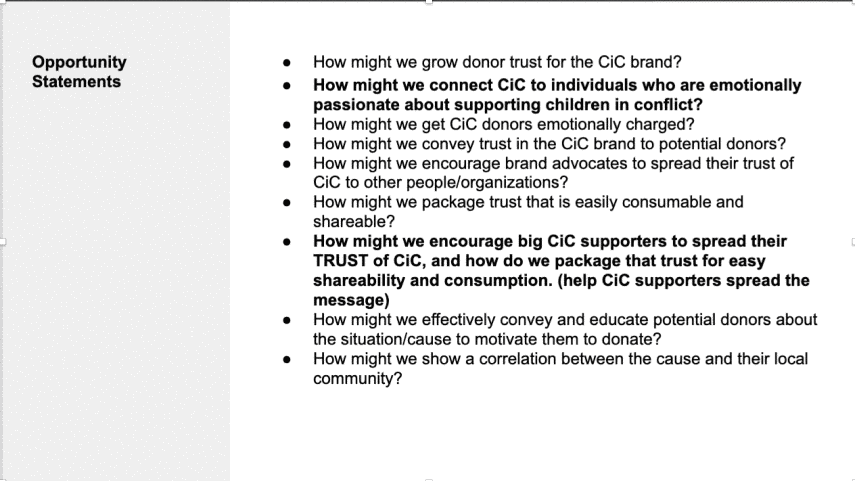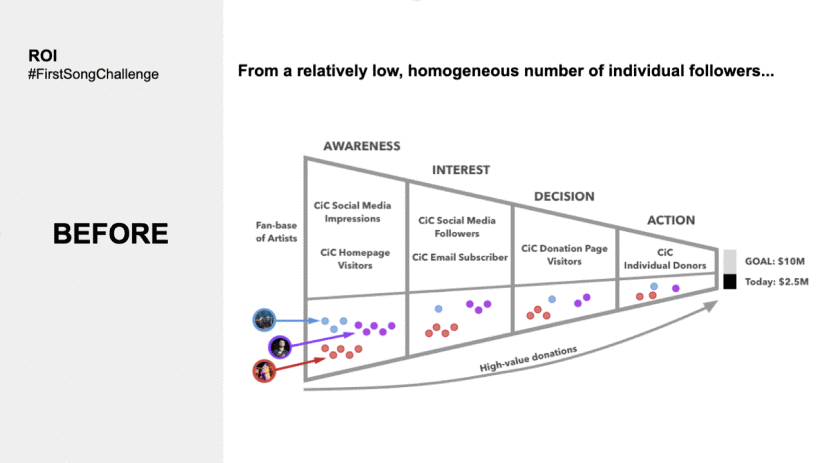

#FirstSongChallenge
december 2018
humanity goes viral
#firstsongchallenge is a social media campaign designed to leverage the reach of a four people fundraiser and to grow awareness while keeping the work load manageable.
I conducted indepth research about donor behaviour and social campaigns and designed the campaign strategy.

The Problem
Having famous celebrities like Sam Smith, Marcus Mumford, and Brandi Carlile as brand ambassadors is definitely very helpful. But in case you only have three employees, their expectations can also keep you busy so that you have zero capacities to proactively grow a healthy regular donor base for your NGO. How can design principles help a non-profit fundraising arm with good connections to the music industry to grow awareness for a good reason?
The biggest challenges that I was facing where were:
-
How to create a growth without growing the workload for the team?
-
How to generate useful solutions on a tight schedule and with zero budget?
-
How to test if a social campaign goes viral?
The Journey

My Team:
2 UX Designers
1 UI Designer
1 Me
Industries:
Non-profit organizations
Music
Online marketing
My Roles:
UX Research
UX Strategy
Campaign Strategy
1. Discovery
When our instructor introduced the class to this real-world case, the vision and the brand of the fundraising arm was just about to get born. Their primary focus was to improve living conditions of children in war zones, after the war is over. Their team was equipped with a web developer, a brand strategist, and the CEO. Their most promising stand-alone criteria was a very good connection to the music industry. Stars like Sam Smith, Marcus Mumford, and Brandi Carlile were ambassadors for the brand which led to a low number of private one-time high-value donors.
Keeping up with their expectations kept the fundraiser team busy. They only received a few private regular donations of some fans on a monthly base via a basic donation homepage. Because of various patent issues in the US, the NGO could not use the brand name of their mother company, which complicated things. Facebook was used as their social media channel, but the number of followers was relatively small. Some success metrics were measured. The number of followers on social channels, the number of donors, and the amount of donations collected represented the main success metrics. The goal was clear: They wanted to grow awareness for their cause to grow the donor base of frequently paying private donors.
I was matched with a group of very international UX students. We played some warm up games and decided how we would like to collaborate.



2. Market & Competitor Analysis
I like to start with a short quantitative research time-box to get a feeling for the environment I am designing for. As the business person in our team, I prepared templates. After a short introduction into the frameworks, we split the analysis work to afterwards present learnings and highlights to each other.
The US fundraising industry is huge. The motivations for people to donate are very diverse. It seemed like donors were giving for what they would believe in. The majority goes to religious institutions, education, and heath services. The fundraiser, Children in Conflict, was directly competing with other fundraising organizations. After marking the position of the fundraiser in the ecosystem we were backed up with enough information to move on.



3. Qualitative Research
As a next step, we wanted to learn about the motivations of people to donate money or time to fundraising organizations. We also wanted to understand more about the pains and gains of people who were working in non-profit organizations. We were on a tight schedule, but nevertheless, we decided to invest at least two weeks for research. We split up and tried to schedule at least two interviews of an hour each so that we would end up with 8 or more interviewees. We prepared a screener to pick our interviewees. After three days we wanted to shared our interviewee recruiting strategies.
I had a hybrid approach. Talking to individual donors was crucial for all of us. To find them, I simply asked people on the streets, if they donated to any organizations and if they would be willing to exchange an hour of their time for a free coffee. To get insights from the corporate side I searched the internet for companies around me, who collected money for a good reason. I found animal shelters, non-profit organizations, and a retail stores which promised to donate a certain amount of every coffee they sell. After the interviews, we had an in-team meeting and presented our findings. We discovered patterns between our interviews and everyone shared their surprising facts.
Key Insights. People donate if the topic matches with their personal believes, if they trust the organization, and if they are in a favorable emotional state. Trust can be reached through transparency or through the person's network. High one-time donations are precious, but frequent smaller amounts are even better, because you can plan with it.



4. Re-framing and Focusing
The discussion in the team was great. We felt inspired and leveled by our exchange. The interviews and the following discussion changed our mindset about the case. Before we were talking about solving a business case. Now we started to realize how loaded by emotions, personal, and deeply human the whole topic of helping others was. We had to find the emotional trigger of potential donors for Children in Conflict to raise money.
We took another look into our research results. Out of the 120 insights, we built clusters and picked three of them to focus on. Then we formulated some meaningful “How might we…” questions. We wanted to use our insights to create as much awareness and interest for Children in Conflict as possible. And we had the musicians to help us. This was our focus.



The social media and website analytics allowed us to analyze quantitatively, who showed interest for Children in Conflict. We were surprised to see that mainly female donors supported Children in Conflict as our basic research predicted another outcome. Why were the females so active? What did they have in common? And then we found the missing piece. They were active followers of the only female musician who supported Children in Conflict, this was the missing piece that led us to our problem statement:
"How might we leverage the existing influencer base to create a social buzz
that triggers the emotions of many potential donors
and converts them into followers, homepage visitors, and newsletter subscribers?"
5. Ideation
I invited the team to an ideation workshop with sticky notes and pin boards, where I applied some ideation techniques. We ended up with at least 200 sticky notes that we pinned on the wall while reading them. Then we clustered the results. Especially one cluster draw our attention. We called it “Go Viral”. If we would be able to use the prominent supporters of Children in Conflict to create a campaign that goes viral, we could scale and boost the limited human resources of Children in Conflict to generate a huge amount of revenues from individual donors. These influencers already came with a huge follower base, and they could again motivate others in the music industry to join. But what makes a campaign go viral?


6. Solution Research and Ideation
The deadline was close, but we stuck to our plan and moved forward with the idea. We wanted to search for common patterns of campaigns that went viral, in order to understand what their success factors. The challenges varied in duration, participants, reasons, tasks, and types. Some were funny, others were very serious. Some were closely linked between the fundraising purpose and the challenge, and some were completely isolated from that. So, what did they have in common?
Whyral?

Identified common patterns:
-
Challenges are somehow easy to physically execute, but mentally challenging for participants.
-
Tasks for participants come unexpected and trigger extreme positive or negative emotions.
-
The campaign starts with one or a few key participants and then spreads into their network.
-
The first participants are crucial. The first posts are identically executed and in most cases performed by prominent people. After a while participants add new elements to the challenge and the execution changes.
We discussed how we could use these insights for our case. After discussing pros and cons of some ideas and letting the class vote, we chose for the #FirstSongChallenge. A social media campaign were our artist should perform a song of their happy or unhappy childhood and invite other artists and fans to join or donate for the cause. We liked the idea, because it was closely linked to the fundraiser's purpose and it created big emotions and trust on the fan's side.


7. Prototyping & Testing



To create a prototype for a viral campaign, we had to be creative. The best way to prototype this idea, was to create a “template” video for our artists. We also created a landing page with information about Children in Conflict and a template for an Instagram post including hashtag and link to the landing page, that could be used by the musicians.
To test our idea, we used our connections to the music industry to presented the idea to semi-prominent artists. The feedback was great. This was the resonance we needed to pitch the idea to Children in Conflict.
The Result
After pitching our idea to the non-profit company and showing them the potential positive effects, they promised us to present the idea to their biggest supporters. We might see it taking place next Christmas. I am looking forward to following the development on Instagram. Even in the case that they never go live with the challenge, I still see this project as a great success, in which I learned a lot about the conscious and unconscious motivation of people to donate and about the power of personal recommendations. I am still very interested to see, if the challenge would take off.
Key Learnings:
-
Recommendations replace complicated information processes. Understanding the psychology underlying personal recommendations, makes it a powerful tool to replace a whole complicated information building process.
-
Secure communication with the stakeholder. We could have communicated our plans with the stakeholders and the artists in an earlier stage, to see, if they were willing to take the “risk” of participating in a viral campaign. We were planning something that was not completely in the hands of our stakeholders. This adds risk to the whole project outcome.
-
Testing if a campaign would go viral is not easy but possible. In our case we should have tested fans of the supporters of Children in Conflict by approaching them online. In that way we could have seen if that would have motivated them enough to visit the homepage, subscribe, and donate.